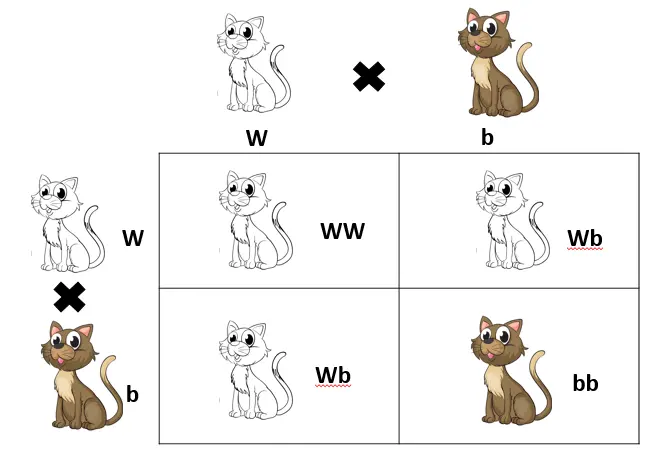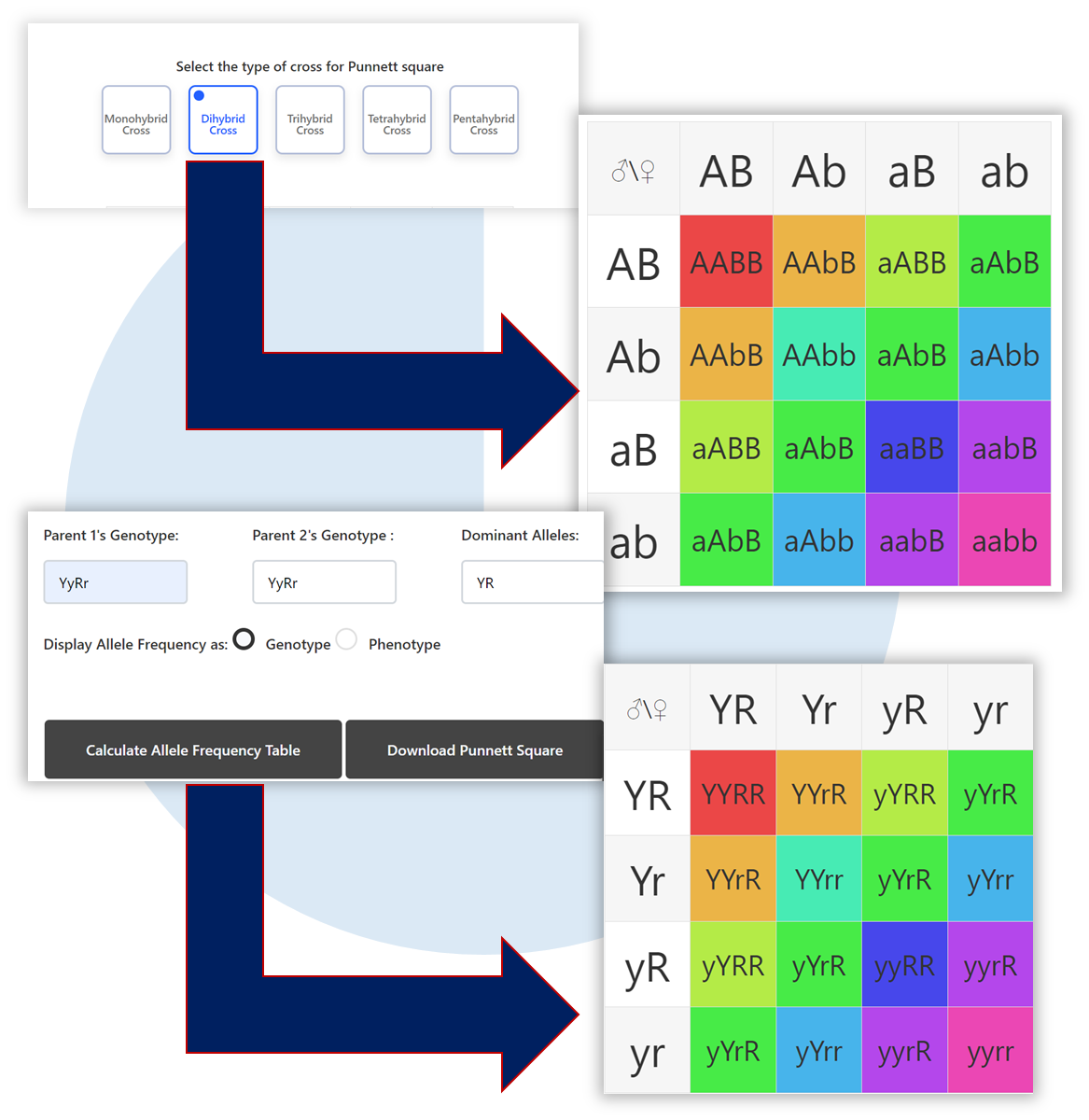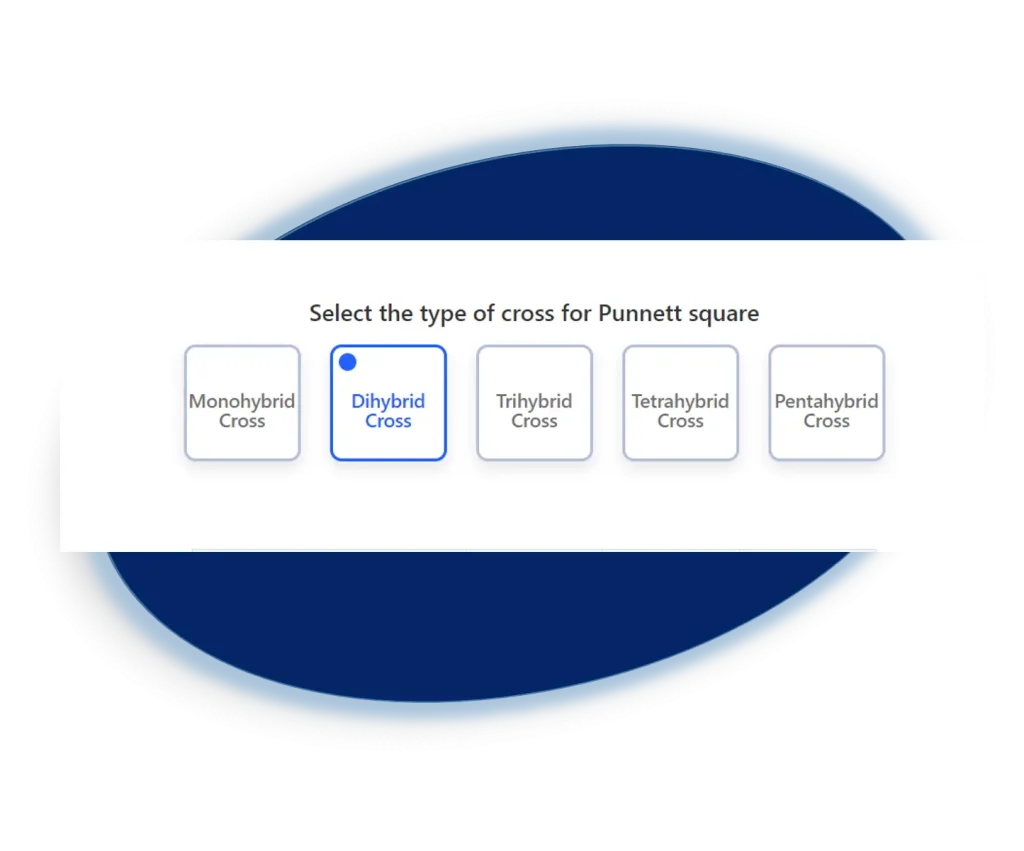Punnett Square Calculator for Monohybrid, Dihybrid and Multihybrid Crosses
Use this amazingly built online Punnett Square generator to visualize genetic crosses in a colourful tabulated form and calculate allele frequency table for better understanding.
Needed a fillable punnett square? Let us make this a fillable one, so that you can change the alphabets from AB to YR or or anything looks better to you. Use the following boxes to customize and personalize your Punnett square. We also allow you to specify dominant alleles yourself.
What Is Punnett Square?
A Punnett Square is a diagrammatic tool used in genetics to predict the possible genotypes of offspring from a particular cross or breeding experiment. Named after the British geneticist Reginald C. Punnett who devised the method in 1905. It’s like a visual organizer that helps us understand how traits are passed down from parents to their children according to Mendelian genetics.
To use a Punnett square, we first need to know the genotypes of the parents. Genotypes are the genetic makeup of an individual, represented by letters. For example, if a trait has two alleles (variants), one dominant (A) and one recessive (a), we often use uppercase letters for dominant alleles and lowercase letters for recessive alleles.
Once we know the parents’ genotypes, we can set up a Punnett square. We write the genotype of one parent along the top and the genotype of the other parent along the side. Then, we cross-multiply the letters to fill in the squares. Each square represents a possible combination of alleles that the offspring could inherit.

Why Use This Punnett Square Generator?
There might be plenty of other tools available on internet to generate a punnett square online but this one posses few unique qualities that makes it stand out. Giving you much freedom to customize and enough items to enlighten you with knowledge.
Thorough Calculations
This tool allows you to generate frequency table of FIVE different crosses, namely: Monyhybrid, Dihybrid, Trihybrid, Tetra and Pentahybrid crosses.
Accurate Results
Experts in the field of genetics supervised the development of this tool and rigorously tested it before releasing the live version. So, the genotypic and phenotypic ratio calculations are accurate.
Free and Easy to Use
Our tool is available to everyone, anytime, and anywhere, making genetics learning accessible at your fingertips.
Customizability
This tool lets you customize the visual look of the generated Punnett square. For example, you can change genotype symbols from "AB" to "YR", Specify you own dominant alleles and many more.
Download Punnett Square
Once you make a punnett square using and customize according to your needs. This tool allow you to download the download it in high quality image format that can be used for future reference or in research/presentation etc.
An Education Tool
Ideal for students and educators, our generator helps simplify complex genetic concepts, making learning interactive and fun.

The Most Advanced and Efficient Punnett Square Maker
Our tool possesses unique characteristics, ranging from an easy user interface to detailed & accurate results, letting you create a Punnett square with multiple uses.
Whether you need to enhance your research article with eye-catching graphics, create engaging presentations for teaching, or being astudent, want to verify your homework solutions, our web-based Punnett Square creator has you covered. In a matter of seconds, you can generate a Punnett Square with your chosen allele pairs, making your work easier and more accurate.
Who's this Web-based Tool Useful for?
Our web-based application offers several advantages for researchers in the field of genetics and biology:
- Time Efficiency: Generate accurate Punnett squares in seconds, significantly reducing the time needed for manual calculations.
- Enhanced Credibility: Ensure the accuracy of genetic predictions, which can bolster the credibility and reliability of your research findings.
- Visual Engagement: Incorporate high-definition graphics into research articles. As the adage goes, “A picture is worth a thousand words.” Using visual aids like Punnett squares can clarify results, support arguments, and engage readers more effectively.
This Punnett square calculator is an invaluable resource for educators, offering multiple benefits:
- Homework Verification: Easily compare and verify students’ Punnett squares and allele frequency calculations. This is particularly useful in large classes where manual checking can be time-consuming.
- Lesson Plan Preparation: Ensure accuracy in lesson planning. Whether designing a new lesson or reviewing complex genetic crosses, this tool simplifies the process and ensures precision.
- Classroom Teaching: Utilize the tool for live demonstrations during lessons. Whether verifying student work or conducting real-time calculations, this tool enhances the teaching experience by providing quick, accurate results.
Students are the primary users of our online Punnett Square maker tool, which supports their learning in several key ways:
Homework Verification: Genetics students can verify their Punnett squares and genotypic or phenotypic ratios against those generated by our tool, ensuring accuracy in their assignments.
Speed Up Exam Preparation: Speed up study sessions by using the tool to quickly calculate complex genetic ratios, such as those in a trihybrid cross. For example, what would normally take 30 minutes by hand can be done in seconds, allowing students to focus on mastering other topics.
How to Use this Punnett Square Creator
This Punnett Square Calculator is designed in such a way that even a beginner can understand and use it correctly. However, to help you achieve your desired results and customize the output to your specific needs, here is a step-by-step guide:

Step 1: Choose the Type of Punnett Square
At the top of the website, you will find a list of five options to choose from:
- Monohybrid Cross (to get 2×2 punnett square)
- Dihybrid Cross (a 4×4 square model is generated)
- Trihybrid Cross
- Tetrahybrid Cross
- Pentahybrid Cross
Step 2: Customize the Visual Table
Once you select the type of Punnett Square, it will automatically update according to your choice. Here’s how you can further customize it:
- Change Genotype for Parent 1 (Father): The default genotype is “AaBb,” where ‘A’ and ‘B’ represent dominant alleles, and ‘a’ and ‘b’ represent recessive alleles. You can change these letters to any other characters you prefer, though ‘A’ and ‘B’ are commonly used.
- Change Genotype for Parent 2 (Mother): Similar to Parent 1, you can modify the genotype for the mother or leave it as the default “AaBb.”
- Specify Dominant Alleles: Enter the dominant alleles (e.g., ‘AB’) in the provided input field. After clicking the “Calculate” button, the Punnett Square will update, with dominant allele combinations highlighted in red for easy identification. If you select the “Phenotype” option, the frequency table will display these alleles as dominant.


Step 3: Calculate and Download
Once you’re satisfied with the Punnett Square’s appearance, you can proceed with the following actions:
Switch Between Genotype and Phenotype: Choose either “Genotype” or “Phenotype” to determine what appears under the “Combination” column in the allele frequency table.
Calculate Allele Frequency Table: After making any adjustments, click the “Calculate” button to update the table. The table will display:
- Allele Combination: The different combinations that appear in the Punnett Square.
- Count: The number of times each combination appears.
- Percentage/Ratio: The proportion of each combination.
- Color: Visual distinctions for easier interpretation.
Download Punnett Square: This option allows you to download the generated Punnett Square as an image file for future reference or use.
Key Terms and Concepts
Following are the terms that are frequently used when talking about Punnett Square or Genetic crosses. It is necessary to have knowledge of these terms in order to fully understand the subject area. We talk about it in brief in the following section.
01
Alleles
Alleles are different versions or forms of a gene that arise by mutation and are found at the same place on a chromosome. Each individual inherits two alleles for each gene, one from each parent. These alleles can either be dominant or recessive and determine specific traits in an organism.
02
Genotype
A genotype in genetics refers to the genetic makeup of an organism, specifically the combination of alleles inherited from both parents. It is represented by letters (e.g., AA, Aa, aa) where each letter represents one allele. The genotype is the underlying genetic code that contributes to an organism’s phenotype.
03
Phenotype
The phenotype is the observable physical or biochemical characteristics of an organism, such as eye color, blood type, or flower color. It results from the interaction of the genotype with the environment. While the genotype provides the potential for certain traits, the phenotype is the actual expression of those traits.
04
Homozygous
An organism is considered homozygous for a specific gene when it has two identical alleles at a particular locus. For example, AA (homozygous dominant) or aa (homozygous recessive). Homozygous individuals consistently express the trait associated with that allele.
05
Heterozygous
Heterozygous refers to having two different alleles for a particular gene at the same locus. For example, Aa. In a heterozygous pair, the dominant allele typically masks the effect of the recessive allele, resulting in the dominant trait being expressed in the phenotype.
06
Dominant Allele
A dominant allele is an allele that expresses its phenotype even when only one copy is present in the genotype (heterozygous). It is usually represented by a capital letter (e.g., A). If an individual inherits a dominant allele from either parent, the corresponding trait will be expressed.
07
Recessive Allele
A recessive allele is an allele that only expresses its phenotype when two copies are present in the genotype (homozygous recessive). It is usually represented by a lowercase letter (e.g., a). If paired with a dominant allele, the recessive allele’s trait is masked and not expressed in the phenotype.
08
Monohybrid Cross
A Monohybrid Cross involves a genetic cross between two individuals that differ in one specific trait, controlled by a single pair of alleles. This type of cross is typically used to examine the inheritance of a single characteristic (e.g., Aa x Aa).
09
Dihybrid Cross
A Dihybrid Cross involves a genetic cross between two individuals that differ in two traits, each controlled by two different pairs of alleles. This type of cross examines the inheritance patterns of two traits simultaneously (e.g., AaBb x AaBb).
10
Trihybrid Cross
A Trihybrid Cross is a genetic cross between individuals that differ in three traits, each controlled by three different pairs of alleles. It is used to study the inheritance patterns of three distinct characteristics (e.g., AaBbCc x AaBbCc).
11
Tetrahybrid Cross
A Tetrahybrid Cross involves a genetic cross between individuals that differ in four traits, each controlled by four different pairs of alleles. This type of cross examines the inheritance of four traits simultaneously (e.g., AaBbCcDd x AaBbCcDd).
12
Pentahybrid Cross
A Pentahybrid Cross is a genetic cross involving five traits, each controlled by five different pairs of alleles. It is used to investigate the inheritance patterns of five traits at once (e.g., AaBbCcDdEe x AaBbCcDdEe).
